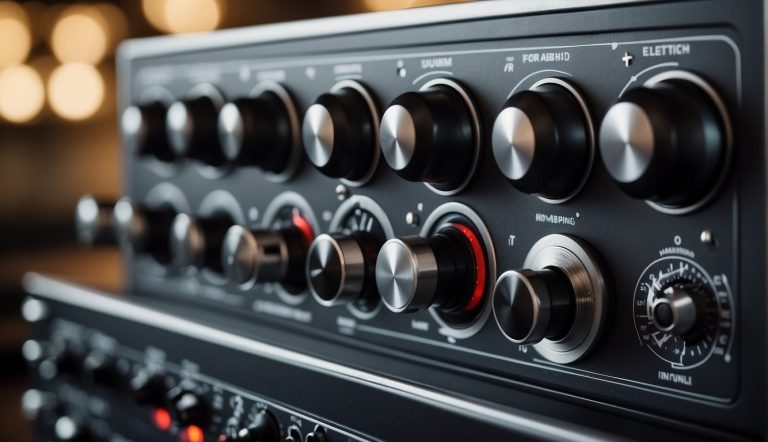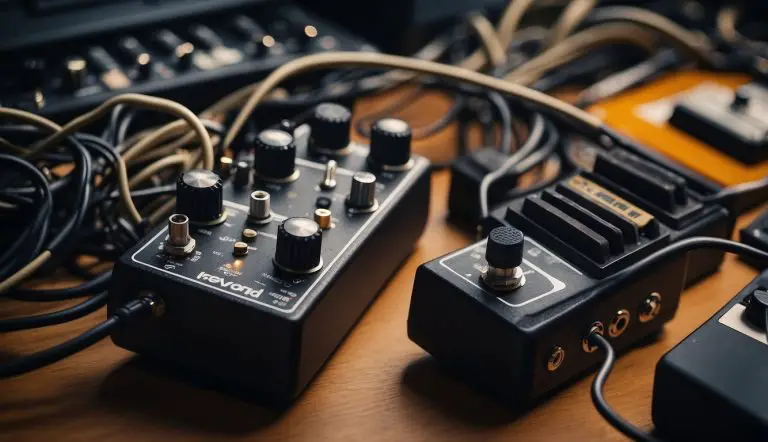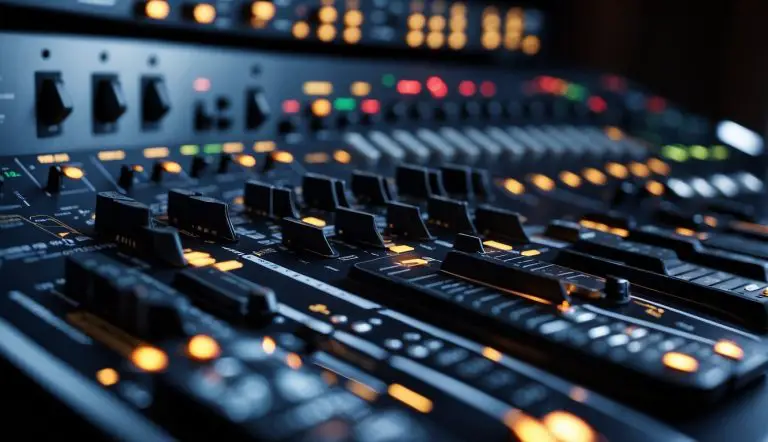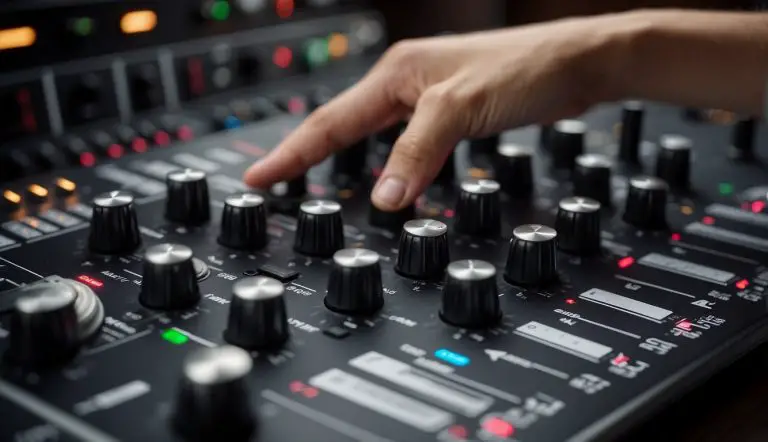How to Use a Delay Pedal: Enhance Your Guitar Sound with These Tips
A delay pedal is an essential tool that adds dimension and depth to the sound of your guitar.
As a guitarist, I find that a delay effect can enrich the music by creating an echo that repeats the notes or chords played.
It’s fascinating how this device captures a snippet of the sound, then plays it back after a short period of time, which you can adjust based on the intended outcome.
This interval between the original sound and its repeated version creates a rhythmic enhancement or a sprawling soundscape, which can transform a simple riff into a textured musical piece.
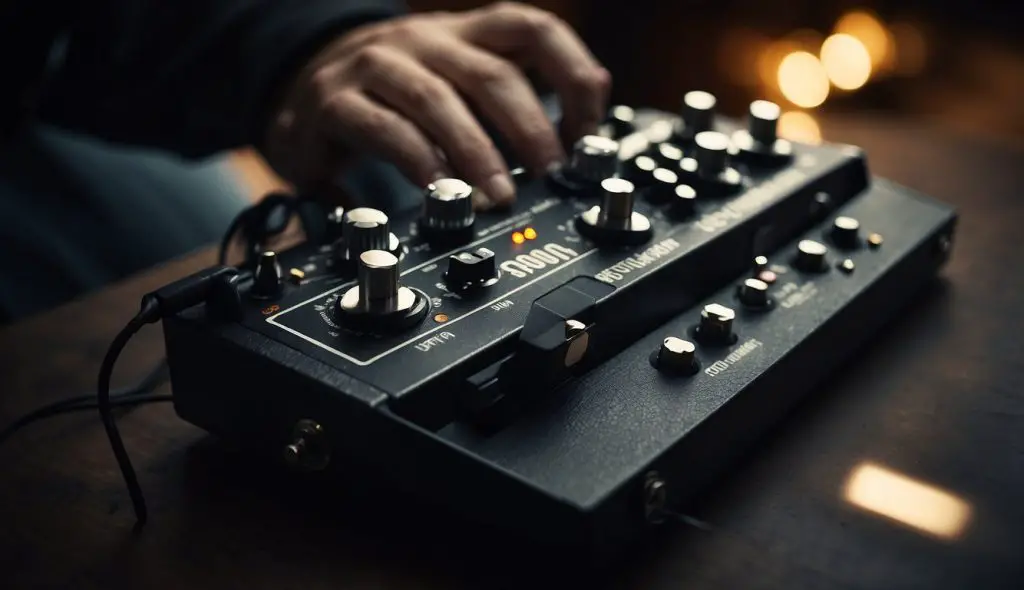
In terms of functionality, delay pedals range from simple, analog designs to complex, digital units with a multitude of knobs and switches. But don’t let that intimidate you.
I believe the key to mastering the use of a delay pedal lies in understanding its basic controls—such as delay time, feedback, and blend or mix—and how they affect your sound.
Whether you want to add a subtle echo to your melody or go for a full-on psychedelic swirl, fiddling with these controls can help you achieve the desired effect.
Practice is crucial; the more you experiment with the delay pedal, the better you’ll understand its potential to enhance your playing style.
Key Points
- A delay pedal can dramatically enhance the sound by creating an echo effect.
- Mastery of a delay pedal comes with understanding and manipulating its core controls.
- Regular experimentation is key to effectively incorporating delay into your guitar playing.
Table of Contents
Let’s Understand Delay Pedals…
When incorporating a delay pedal into my guitar rig, I find it crucial to understand the varieties available, how their basic controls shape the sound, and what advanced features can do for my playing.
Types of Delay Pedals
Delay pedals come in several forms, each with its own sonic characteristics. Digital delay pedals are known for their crisp, precise echoes and often include a variety of programmable options.
Analog delay pedals, on the other hand, use analog circuitry to produce warmer, sometimes slightly degraded repeats which many find musical and atmospheric.
Tape delay is the granddaddy of delay types, originally using magnetic tape to create echoes. Modern tape delay pedals aim to replicate the distinct warmth and character of these vintage units, often incorporating wow and flutter for authenticity.
Basic Delay Pedal Controls
Every delay pedal I’ve used features a set of core controls that allow me to customize the echo effect:
- Time: This control dictates the interval between the repeats, typically measured in milliseconds. By adjusting the time, I can create everything from a rockabilly slap-back to cascading ambient washes.
- Feedback: Also known as repeats, this knob lets me set how many echoes are heard. Turning it up results in more repeats before the delay fades away.
- Level/Mix: With this control, I determine the volume of the delayed signal in relation to my dry guitar tone. Higher settings make the delay more pronounced, while lower settings offer a subtle background texture.
Some delay pedals also have a Tap Tempo feature, which lets me set the delay time to match the song’s tempo with a few taps of a footswitch.
Advanced Features and Functions
Taking things further, advanced delay pedals come packed with additional functionalities that unleash a plethora of sonic possibilities:
- Subdivision: This feature allows me to divide the delay time into rhythmic subdivisions, adding complexity to my soundscape.
- Mode: Many digital delays offer different modes that emulate analog or tape delays or provide unique sounds like reverse and shimmer delays.
- EQ/Filter: Sometimes there’s an EQ or filter section to sculpt the frequency content of the repeats. It helps me in making the delay sit perfectly in my mix.
- Modulation: Modulation adds movement to the delay effect, creating variations in pitch and time that can range from subtle to very dramatic.
- Stereo Outputs: For expansive stereo soundscapes, some pedals offer stereo outputs that can ping-pong the delay between two amplifiers.
Setting Up Your Delay Pedal
When I set up my delay pedal, I make sure that it integrates seamlessly into my signal chain and that the settings are optimized for the specific genre I’m playing. This ensures I maintain the integrity of my original signal while crafting the desired sound.
Integrating Delay into the Signal Chain
Firstly, I consider where to place the delay pedal in my signal chain.
Typically, I run my guitar into the tuner pedal, then through any dynamic or drive pedals like compressors or overdrive, and then into modulation effects before finally reaching the delay pedal. This order ensures that the original signal is cleanly modified before the delay is applied.
To integrate it, I connect my guitar to the input of the delay pedal and then run a cable from the delay’s output to the amp. If my pedal has stereo outputs, I utilize two amps for a richer, more spacious delay effect.
I also consider the pedal’s power requirements; most need at least 9V of power, so I use the appropriate adapter or battery.
To maintain the original tone, I connect my delay pedal’s send and return jacks to an effects loop, if my amp has one. This lets me blend the processed (wet) and unprocessed (dry) signals effectively, usually by adjusting the pedal’s mix or level control.
Optimizing Delay Settings for Different Genres
For different genres, I tweak the delay time, feedback, and mix settings to fit the mood:
- Rock / Pop: I aim for a clear echo that doesn’t muddle my guitar playing, generally setting the time between 300-500 milliseconds with moderate feedback.
- Ambient / Worship: I set a longer delay time, often above 600 milliseconds, with higher feedback for a wash of sound.
- Country / Blues: I dial in a slap-back delay, setting the time between 100-200 milliseconds with minimal feedback for a subtle repeat.
When adjusting settings, I keep in mind the tempo of the song. For a cohesive sound, I often tap the pedal’s tap tempo feature (if available) to sync the delay time with the beat of the music.
Creative Applications of Delay
Delay pedals are powerful tools that add a new dimension to your guitar playing, allowing you to create a range of sonic landscapes from subtle texture enhancements to complex rhythmic patterns. I’ll take you through some specific techniques to elevate your sound and craft iconic guitar tones.
Adding Depth and Dimension to Your Sound
When I first plug in my delay pedal, my goal is often to enrich the sound with added depth and dimension. To achieve this, I use a technique known as slapback delay, which refers to a single repeat echoing back quickly after the played note. This creates a three-dimensional quality in the sound that makes it feel fuller and more present.
- Settings for Slapback Delay:
- Delay Time: 80-160 ms
- Feedback: Low (usually one repeat)
- Mix: Adjust to taste for subtlety
With these settings, I can add body to my tone without overwhelming the original signal, subtly infusing my sound with a sense of ambience that’s ideal for both rhythm playing and solos.
Crafting Iconic Guitar Tones
Looking to emulate the edge-laden tones of U2’s The Edge? It’s his tactical use of dotted eighth note delay that’s key. Especially in songs like “Where the Streets Have No Name” and “Pride (In the Name of Love),” the delay doesn’t just complement the guitar’s natural sound but becomes integral to the rhythm and tone.
- Settings for Dotted Eighth Note Delay:
- Delay Time: Set to a dotted eighth note relative to the song’s tempo
- Feedback: Medium to high for more repeats
- Mix: Balance for a blend where the echo sits with the original note
The precision in timing coupled with the right balance of feedback and mix creates rhythmic sounds that can simulate multiple guitars playing in sync. Each strum or pluck evolves into a cascade of notes, building complex textures that are rhythmically engaging.
Using these techniques, my delay pedal doesn’t just echo notes; it creates an expanded sonic field where reverb and repeat mesh to give rise to a distinctive guitar voice. Whether thickening up a guitar solo or embedding a rhythmic pattern within a band’s mix, careful tweaking of delay settings can make a substantial difference to the final output.
Frequently Asked Questions
In this section, I’ll address some of the concerns you might have about using delay pedals. Whether you’re a beginner or looking to refine your technique, these FAQs are designed to guide you through the basics and best practices.
What are the essential settings to know when using a delay pedal for the first time?
When you first plug into a delay pedal, familiarize yourself with three key settings: Time, Feedback, and Mix. Time controls the delay length between your original note and the repeated echo, Feedback determines the number of echoes, and Mix sets the balance between the effect and your dry signal.
Which delay pedals are considered the best for a tight budget?
For guitarists on a budget, models like the Donner Yellow Fall and the Behringer VD400 offer great value. They provide a good range of delay types and sturdy construction without breaking the bank.
How can I effectively use a delay pedal for rhythm guitar parts?
To enhance rhythm parts, I set my delay pedal with a shorter delay time and moderate feedback to add depth without overwhelming the mix. Tapping the pedal in time with the music ensures that the delay complements the rhythm.
What are the optimal delay pedal settings for playing lead guitar?
When playing lead guitar, I find a slightly longer delay time helps my solos stand out. Dialing back the mix allows the effect to sustain my notes without overpowering them. Experimenting with feedback can also add a rich, immersive texture to lead lines.
In what order should I place a delay pedal in my guitar effects chain?
I recommend placing a delay pedal towards the end of your effects chain. This allows it to process the compounded signal from your other effects, resulting in a more cohesive and defined echo.
How can a stereo delay pedal enhance my guitar sound compared to mono?
A stereo delay pedal can create a wider, more spacious sound by sending distinct delay signals to two different amplifiers or tracks. This results in a bigger, more immersive ambient sound that is especially noticeable in live settings or recordings.


